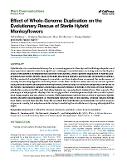Effect of Whole-Genome Duplication on the Evolutionary Rescue of Sterile Hybrid Monkeyflowers

Author
Meeus, Sofie
De Storme, Nico
Geelen, Danny
Vallejo-Marin, Mario
Publication date
2020Published in
Plant communicationsVolume / Issue
1 (6)ISBN / ISSN
ISSN: 2590-3462Metadata
Show full item recordCollections
This publication has a published version with DOI 10.1016/j.xplc.2020.100093
Abstract
Hybridization is a creative evolutionary force, increasing genomic diversity and facilitating adaptation and even speciation. Hybrids often face significant challenges to establishment, including reduced fertility that arises from genomic incompatibilities between their parents. Whole-genome duplication in hybrids (allopolyploidy) can restore fertility, cause immediate phenotypic changes, and generate reproductive isolation. Yet the survival of polyploid lineages is uncertain, and few studies have compared the performance of recently formed allopolyploids and their parents under field conditions. Here, we use natural and synthetically produced hybrid and polyploid monkeyflowers (Mimulus spp.) to study how polyploidy contributes to the fertility, reproductive isolation, phenotype, and performance of hybrids in the field. We find that polyploidization restores fertility and that allopolyploids are reproductively isolated from their parents. The phenotype of allopolyploids displays the classic gigas effect of whole-genome duplication, in which plants have larger organs and are slower to flower. Field experiments indicate that survival of synthetic hybrids before and after polyploidization is intermediate between that of the parents, whereas natural hybrids have higher survival than all other taxa. We conclude that hybridization and polyploidy can act as sources of genomic novelty, but adaptive evolution is key in mediating the establishment of young allopolyploid lineages.
Keywords
allopolyploid, Erythranthe, Mimulus, polyploidy, speciation, whole-genome duplication
Permanent link
https://hdl.handle.net/20.500.14178/1762License
Full text of this result is licensed under: Creative Commons Uveďte původ-Neužívejte dílo komerčně-Nezpracovávejte 4.0 International







